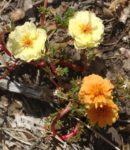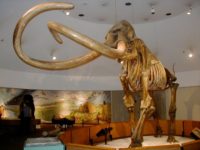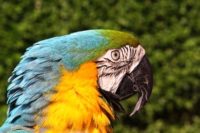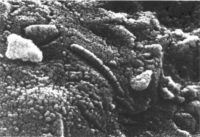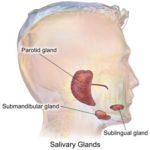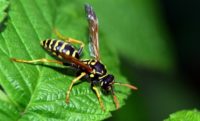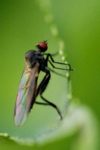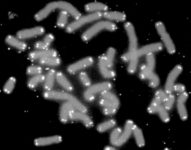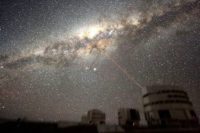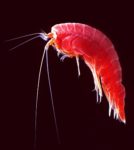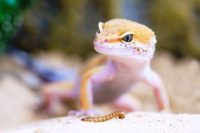By Creation Moments Evolutionary scientists tell us that mutations were central to the production of the great variety of creatures on earth today from the first living cell. At the same time, biologists admit that 99 percent of all mutations are harmful. read more …read more Source: Creation Moments
By Creation Moments We all know that we each started out as a single cell in our mother’s womb. Then those cells began to divide and within 21 days we had a working nervous system and a beating heart. How did all those new cells know how to hook up to each other to knit together our nerve connections? How do other cells know to hook up with each other to make our circulatory system, or form the heart? read more …read more Source: Creation Moments
By Creation Moments Will the mammoth walk the earth again? At one time, herds of these giant creatures, which stand 10 to 12 feet tall at the shoulder, covered North America, Europe, Asia and Africa. In late 1999, Russian and American scientists excavated a buried, frozen mammoth in Northern Siberia. read more …read more Source: Creation Moments
By Creation Moments According to evolution theory, birds should not have been around at the time of the dinosaurs. This is especially true of the parrot, which is supposed by those who believe in evolution to be a more highly-evolved bird. read more …read more Source: Creation Moments
An accountant wonders how people can separate fact from faith in scientific claims, and biologist Jonathan Wells (author of Zombie Science) and playwright Matt Chait respond. Listen: https://discovery.org/multimedia/audio/2017/09/separating-fact-from-faith-in-science/
On this episode of ID the Future, enjoy an excerpt from Discovery Institute’s documentary Revolutionary. It’s been more than a decade since the judge handed down his decision in the Dover intelligent design trial. At the time the mainstream media told the world one story about the trial. Now Revolutionary tells the rest of the story – recounting Behe’s defense of the bacterial flagellum as an example of irreducible complexity, and criticisms of Judge Jones’ decision. Watch Revolutionary now, available for free online at www.revolutionarybehe.com. Listen: A Revolutionary Look at the Dover Decision 11 Years Later | Multimedia Library
A Doctor Examines Some Intricate Control Systems Sustaining Your Life Right Now | Multimedia Library
On this episode of ID the Future, Ray Bohlin interviews Physician Howard Glicksman about a common cause of death, cardio-pulmonary arrest, using the subject as a doorway to explore some intricate, interdependent control systems that sustains life. Dr. Glicksman is a medical doctor and author of an extended series of posts at Evolution News & Science Today, “The Designed Body.” Listen: A Doctor Examines Some Intricate Control Systems Sustaining Your Life Right Now | Multimedia Library
By Creation Moments How small can a living thing be and still be considered alive? Viruses are not considered living things because they cannot reproduce on their own. But now scientists have confirmed the existence of bacteria that are smaller than the largest viruses and yet can reproduce on their own. They call this amazing class of bacteria nanobacteria. They are less that 20 percent the size of normal bacteria. read more …read more Source: Creation Moments
A biology professor who grew up under communism shares what it was like to live in a society based on Darwin’s theory of evolution. He also discusses some amazing evidence of intelligent design in our cells. Biologist Jonathan Wells, author of Zombie Science, and political scientist John West, author of Darwin Day in America, both respond. This conversation was taped live in Hollywood during a discussion after the final performance of Disinherit the Wind, a play that tells the story of a neurobiologist who sues his university for the right to challenge neo-Darwinian evolution. Listen: Disinherit the Wind: Growing Up [More]
By Creation Moments Someday, instead of having to give a blood sample during your physical exam, the doctor might just ask you for a saliva sample. Saliva is an amazing fluid. Besides helping us moisten and digest food, saliva is able to speed healing and fight bacteria, fungi and viruses. Saliva is chemically almost identical to the clear part of your blood. It even has, in lesser concentrations, the infectious organisms found in your blood. read more …read more Source: Creation Moments
On this episode of ID the Future, Robert Crowther asks biologist Jonathan Wells, author of Zombie Science, what icons of evolution students should be on the lookout for as they head back to school. Wells says there are several still in wide circulation. Listen: Back to School: A Guide to Bogus Evidence for Evolution | Multimedia Library
By Creation Moments For thousands of years the Bible has taught that there is a link between spiritual health and physical health. When rationalism came along, many sought to deny the spiritual aspect of humans. For them, the spiritual and the material have nothing to do with each other. Even medicine was, and still is, taught and practiced by many without any consideration of human spirituality. read more …read more Source: Creation Moments
By Creation Moments The creation is filled with plants and animals which use deception to survive. The glow in the dark cookie-cutter shark is a master at such deception. read more …read more Source: Creation Moments
By Creation Moments Two strange species of orchids are among the rarest flowers in the world. These unconventional plants live their entire lives underground, even flowering underground. Most often, their flowers never break the surface of the ground. One of these species, Cryptanthemus, has been found only three times in this century. Only 150 flowering Rhizanthella plants have ever been found. read more …read more Source: Creation Moments
By Creation Moments The first book that urged us to take good care of the earth was the Bible. The Bible also reminds those who would be careless about their responsibilities that there is a Creator who is going to hold us accountable for how we carry out our responsibilities. Why, then, does Christianity always seem to be taking the blame for destruction of the environment? read more …read more Source: Creation Moments
On this episode of ID the Future, Ray Bohlin interviews physician Howard Glicksman about hemoglobin and the body’s need to have enough of it to transport sufficient oxygen to the tissues. Finely-tuned and exquisitely engineered, this system gave our ancestors enough oxygen to not only stay alive but thrive in the face of hostile challenges. […] Listen: https://discovery.org/multimedia/audio/2017/09/a-doctor-examines-how-the-body-meets-its-need-for-oxygen/
By Creation Moments Wasp colonies in temperate zones usually wait until the end of summer to raise male young. That’s because male wasps are typically useless consumers of food. They don’t do anything worthwhile in the nest, nor do they help gather resources. read more …read more Source: Creation Moments
By Creation Moments Human bridegrooms are not the only males who give gifts to their intended. The birds and the flies do it, too. On a previous program we talked about how the bower bird woos his potential mate by building a hut for her and decorating it with bright objects. read more …read more Source: Creation Moments
By Creation Moments We all instinctively know that worry and anxiety are not good for us. Previous studies have shown that stress affects our health and makes our immune systems less efficient. But somehow that knowledge doesn’t seem to be enough to keep us from fretting about the challenges and problems of life. read more …read more Source: Creation Moments
By Creation Moments Before the Flood, people were living hundreds of years. As man grew more evil, God declared that man’s lifespan would be reduced to 120 years. Modern biology has learned that we do indeed have built-in timers in each of our cells that limit the number of times they can divide. When enough cells can no longer divide, we die. We can even do things to speed up the timers. read more …read more Source: Creation Moments
By Creation Moments A debate about the definition of “species” may remove Homo erectus from the human evolutionary tree. read more …read more Source: Creation Moments
By Creation Moments When we look at the size of the universe, it sometimes becomes easier to see evolution as credible. After all, when we see galaxies that are said to be billions of light years away, it seems possible that there really have been millions of years. But, in truth, the immensity of space is really not so friendly to evolution’s claim that the universe, and the earth, are billions of years old. read more …read more Source: Creation Moments
By Creation Moments The hunted are smart to stay downwind of the hunter. Many predators hunt using scent, at least in part. The same principle works in water. Many predators smell chemicals given off by their prey and use that scent to help them locate their prey. If you were a predator in a stream you would be smart to stay downstream from your prey. The prey won’t smell you. read more …read more Source: Creation Moments
By Creation Moments The bacterium Bacillus cereus likes to live in soil that would kill most other bacteria. It’s bothered neither by lethal concentrations of metal nor natural antibiotics. read more …read more Source: Creation Moments
By Creation Moments The news has again been filled with stories about the search for planets orbiting nearby stars. All these stories assume that our Earth was not formed by God. They perpetuate the idea that the Earth and other planets in the solar system formed when dust around the young sun began to collect into lumps. read more …read more Source: Creation Moments
By Creation Moments You get up early. The illumination isn’t very good, you put on your socks anyway, only to find out, in the light of day, that you have one blue and one gray sock on. That’s because our eyes have cone cells to detect color, as well as rod cells that are sensitive to light, but cannot see color. So, as the light level becomes lower, we have a decreasing ability to detect colors. read more …read more Source: Creation Moments
By Creation Moments Many marine creatures reflect surrounding light. They can do so because of tiny light-reflecting platelets. Typically, these crystalline platelets are made of purine, one of the building blocks of DNA, but these particular crystals cannot change how much light they reflect. read more …read more Source: Creation Moments


















